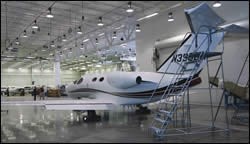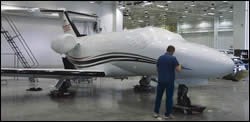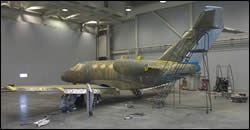Painting a Mustang
How Cessna finishes its newest business jet
Tucked into the southeastern corner of Kansas is Independence, a small town with a big reputation in the world of civil aviation.
The city has earned that reputation largely due to the presence of a single company. Now a unit of Textron Inc., Cessna Aircraft Co. has produced more than 7,000 single-engine airplanes at its Independence plant since 1996. In the 80 years since its founding, the company has delivered nearly 190,000 planes ranging from single-engine, piston-driven models to Citation business jets.
The newest addition to Cessna’s Citation lineup is the Mustang very light jet (VLJ). The six-place Citation Mustang has a top speed of nearly 400 mph, a range of 1,150 nautical miles (1,323 statute miles) and a service ceiling of 41,000 ft, which will enable it to fly above most weather and commercial traffic for more efficient operations. According to Cessna, the plane’s price tag of $2.6 million and estimated operating cost of $2.06 per nautical mile will help bring the speed, range and comfort of private jets to more people at less cost than current turboprop aircraft.
The Citation Mustang is fabricated mainly from aluminum alloy materials using traditional spar and rib construction. It does feature some composite components, such as radomes and fairings, but the wings and fuselage are fabricated from aluminum alloys. The plane and production process received full approval from the Federal Aviation Administration (FAA) last September, and Cessna delivered the first jet to a customer in November.
Unlike other Citation jets, which are assembled in Wichita, KS, the VLJ is being produced in Independence. Subassemblies produced at other locations for both the Mustang and single-engine planes are brought together in the location’s 400,000 sq ft main building. The plant does not fabricate detail parts, but rather functions more as an integrator of various aircraft sub-systems, according to Terry Clark, director of Support Services and Paint.
Basing Mustang production in Independence makes a lot of sense from the finishing perspective, Clark says. “We use the same paint facilities for all the products we build here,” he explains. “The experience we gained painting more than 7000 single-engine planes helped tremendously in developing finishing processes for the Mustang.”
The paint facility at Independence has dedicated booths and preparation areas for the Mustang, but Clark says the plant shares other resources across the four aircraft models produced there, including the experience of some of the more than 100 paint shop personnel. “That’s especially valuable now that we’re ramping up production on the Mustang,” he says. “It enables us to bring experienced people over from the single-engine products to work on the Mustang. So we share talent across all the product lines we build.”
Pre-paint Prep
According to Clark, the Mustang finishing process has more in common with the processes used on other Citation jets than it does with the paint process for Cessna’s single-engine aircraft.
Finishing starts in a preparation building dedicated to sanding and other work that emits debris and could contaminate the paint finish. The 10,000 sq ft building features two, 4,800 sq ft sanding bays. Operators work with pneumatic sanders to start the finishing process by smoothing the shipping primer that coats most subassemblies when they arrive at the plant.
“In the aviation business, corrosion prevention and protection is a big part of what we do,” Clark explains. “That holds true even from the time the parts are produced. So detail parts, as they’re fabricated, receive a coat of polyamide epoxy primer. Then, as the detail components are joined together into subassemblies, unexposed surfaces are also coated with the primer. So the first thing we do when the Mustang goes in to the prep facility is sand smooth the shipping primer. That way we know we’re starting with a substrate with a consistent finish and thickness.” Operators wear fresh air suits during sanding, and aim to sand the two-mil thick shipping primer down to about 0.5 mils.
The next phase of surface preparation is application of a new coat of corrosion primer 0.5–1 mil thick, followed by application of a sanding surfacer to a thickness of 3–5 mils. “The sanding surfacer is something the Mustang has in common with other Citation jets,” Clark says. “We don’t do that on our single-engine products; it would add too much cost and weight to the airplane.” The surfacer is used to level the substrate and enhance finished paint appearance, he adds.
After the surfacer cures it’s back to the sanding booth. There, workers sand the total film build down to a thickness of about three mils. “Of course, throughout this procedure we’re masking the airplane, and cleaning and prepping surfaces to meet a very stringent set of specifications,” Clark points out.
To the Paint Booth
After surface prep, the airplane moves to an 80,000 sq ft paint building for top coating and striping. The facility houses five, 3,200 sq ft cross-draft paint booths for top coat and a down-draft booth used for striping.
The Mustang’s top coat is a high-solids polyurethane Cessna developed in conjunction with Dupont. It’s the same material used on single-engine aircraft. “The material allows us to paint riveted structures like our single-engine products, where you have a lot of button-head rivets on the airframe,” Clark says, “but it also provides the kind of flow we need to satisfy the requirements of the Mustang jet.”
In the booth, two painters work using HVLP guns and spraying out of 10-gal pots to a nominal film build of 2.5 mils. “We’ve tried to use an automated pre-mix system, but we see the need to adjust the component ratios at application for varying humidity and other conditions,” Clark explains. “The pre-mix system doesn’t give us enough flexibility to do that, so that’s why we’re still painting out of pots.”
The paint shop is also just starting to employ some electrostatic equipment in top coat application, according to Clark. “We haven’t yet fully realized the benefits of electrostatics, but we expect less overspray, lower VOC emissions and improved life on the fiber filters we use in our cross-draft booths. Eventually, the entire topcoat of the plane will be applied with electrostatics,” he says.
All Mustangs receive the same white top coat, but customers can choose from five different stripe designs and a large color palette. Stripes are laid out using masking templates based on adhesive-backed vinyl masking material that has been precut by a vendor; Cessna personnel simply place the required template on the airplane. “This system lets us do the masking quickly and still offer some variety in stripe designs,” Clark says.
To produce stripes, painters spray a base coat/clear coat product in a variety of pearl and metallic colors. Film build on the stripes varies depending on the hiding characteristics of the particular color being used, Clark says. “Some colors cover a lot better than others and that drives the film thickness we need on the stripes.”
All paint booths include air makeup systems to help speed drying. Cessna also uses a drying oven to accelerate paint curing for about six hrs at 120°F.
The full Mustang prep and paint process now takes about 12 days, but Clark expects to reduce cycle time to eight days when production ramps up. “Right now we’re building Mustangs at what we call a fill rate,” he says. “We’re building up, but we don’t have them consistently in the paint shop.” Cessna expects to deliver 40 of the VLJs this year and aircraft number 10 was in the finishing process as this was written.
Quality Control
As you might expect, Cessna puts a big emphasis on quality and reliability. Clark says the company’s engineers do a lot of work up front to qualify materials, and the production plants emphasize development and use of standard operating procedures for process repeatability.
“We have a large team of product and process engineers, most working out of our Wichita facility, and they’re always testing new products and processes,” he explains. “Before we introduce any product or process on an airplane it has to pass any tests they design. A paint finish, for example, may have to endure thousands of hours of salt spray testing. It’s a very stringent process designed to ensure that we’re not going to have aircraft in the field with reliability issues.
“At the plant level, a very big part of our process is using standard operating procedures,” Clark continues. “This includes how we mix paint, how we prepare the airplane, and what the painters do when they get in the booth. We don’t just paint haphazardly. We paint prescribed areas in sequence so, for example, one painter is not spraying contaminants toward another painter.
“The more process controls we have in place, the better the product will be and the more efficient we’ll be,” he says.
Despite the focus on up-front quality, Mustang paint finishes are still subjected to a battery of inspections before a plane is released. Clark says the checks are performed by the same painters who finish the aircraft, and include visual inspection for rivet runs and contamination as well as checks of gloss, orange peel, and coating thickness.
“Coating thickness is very critical in a way that’s maybe a little different than other industries,” he says. “The issue for us is coating weight. We measure thickness so we can calculate the weight of the coating at every step along the way and monitor how much weight we’re adding to the airplane.”
Results of all checks must meet the Manufacturing Acceptance Criteria (MAC) Cessna engineers have established for the Mustang. “The MAC outlines our allowable limits for orange peel, for gloss, and other factors. So before we release the airplane to a customer, it has to be within our limits in all the areas we check.”
Rework generally involves sanding and repainting an area of the airplane, but according to Clark the plant tries to keep it to a minimum. “We really strive to make sure that the airplane meets the MAC when it comes out of the paint booth,” he says. “That’s the time to control the quality of the paint; any time you touch the paint job after that is less than optimal.”
Training and Six Sigma
Quality, reliability and productivity are also being improved by increasing use of six sigma thinking at Independence and throughout Cessna, according to Clark. “Six sigma gives us a set of tools that greatly improve our ability to understand the root cause of a problem and determine the corrective action needed to solve it,” he says.
The workers in Cessna’s corporate labs also can provide support for production facilities experiencing quality problems, Clark adds. “They can do a whole variety of tests to help determine the cause of a problem. For example, we recently had some contamination issues on the finish of our single-engine planes,” he recalls. “We took samples of the contaminant to the lab and had them analyzed. They turned out to be cotton fibers from a dust mop we had just started using. So we changed the mop heads from cotton to nylon.”
In terms of training, Independence is trying to leverage the knowledge and experience of its more seasoned painters to help develop the overall skill level of paint shop personnel. “Our painters used to spend most of their time in the paint booth,” Clark explains. “Now, the lead painter follows a plane from preparation to painting to post-paint cleanup in preparation for delivery to the customer. So we have these very experienced people working along side relatively inexperienced people who will learn from the expert.”
The facility also does other types of classroom and hand-on training, and managers are gearing up to launch a new painter development academy in the next few months. “The academy will help us develop personnel with less experience into better painters,” he says. “We’ll use six sigma tools to perform a skills gap analysis and evaluate the experience and capability level of each individual, then get them into the training program at the point they need to be and continue developing them.”
Related Content
Curing Oven Basics
Simply heating up the substrate does not cure the coating. There are many variables to consider when choosing the best cure oven for your application...
Read MoreProducts Finishing Reveals 2024 Qualifying Top Shops
PF reveals the qualifying shops in its annual Top Shops Benchmarking Survey — a program designed to offer shops insights into their overall performance in the industry.
Read MoreHenry Ford Is Still Right When It Comes to Color
Who would have imagined that more than 100 years after his famous statement about any color as long as it’s black would still have relevance of a sort?
Read MoreTTX’s Automated Conveyor Carrier System Offers Wireless, Flexible Operation
ACC system designed for reliable, consistent point-to-point movement of everything from small to heavy parts.
Read MoreRead Next
Episode 45: An Interview with Chandler Mancuso, MacDermid Envio Solutions
Chandler Mancuso, technical director with MacDermid Envio discusses updating your wastewater treatment system and implementing materials recycling solutions to increase efficiencies, control costs and reduce environmental impact.
Read MoreEducation Bringing Cleaning to Machining
Debuting new speakers and cleaning technology content during this half-day workshop co-located with IMTS 2024.
Read MoreDelivering Increased Benefits to Greenhouse Films
Baystar's Borstar technology is helping customers deliver better, more reliable production methods to greenhouse agriculture.
Read More

























